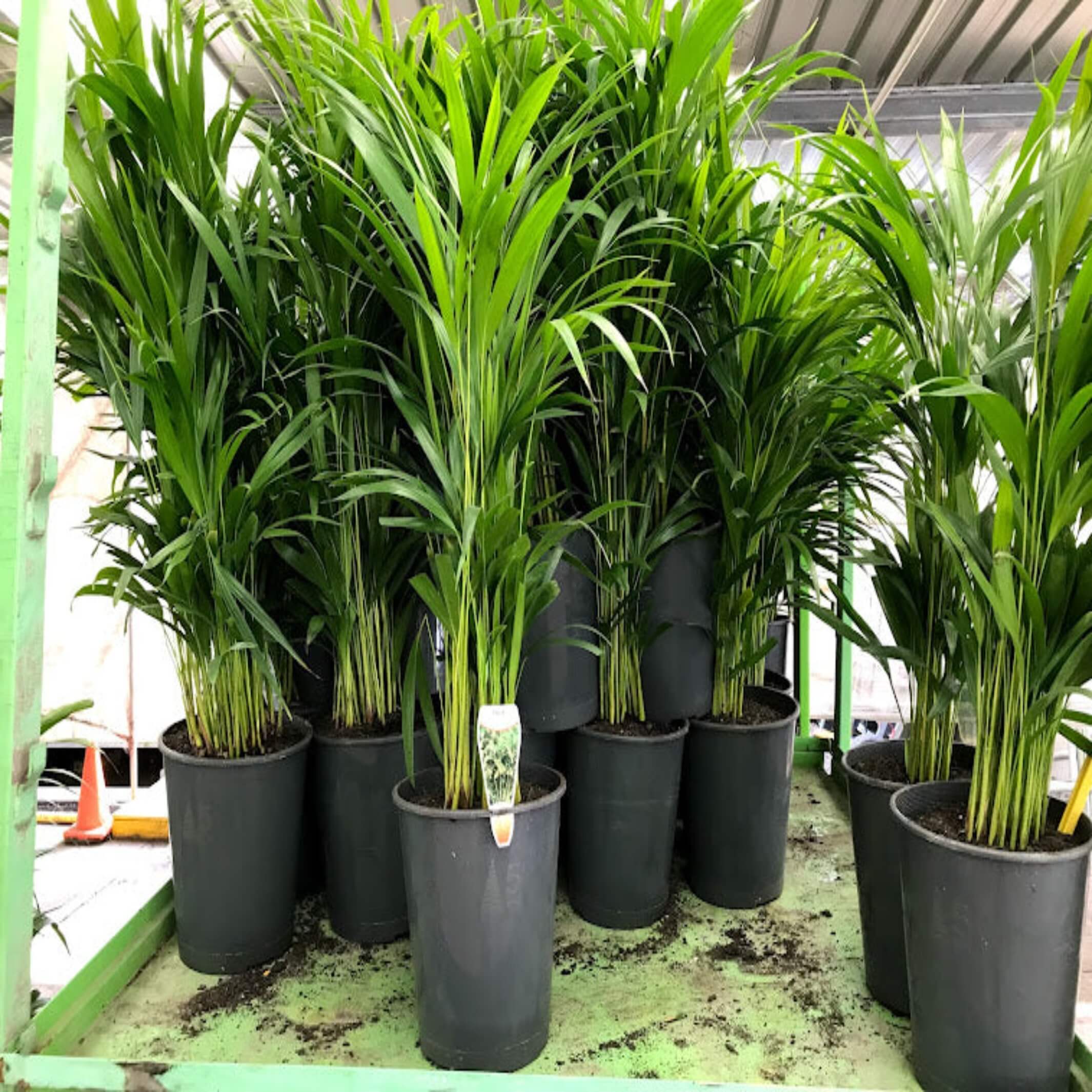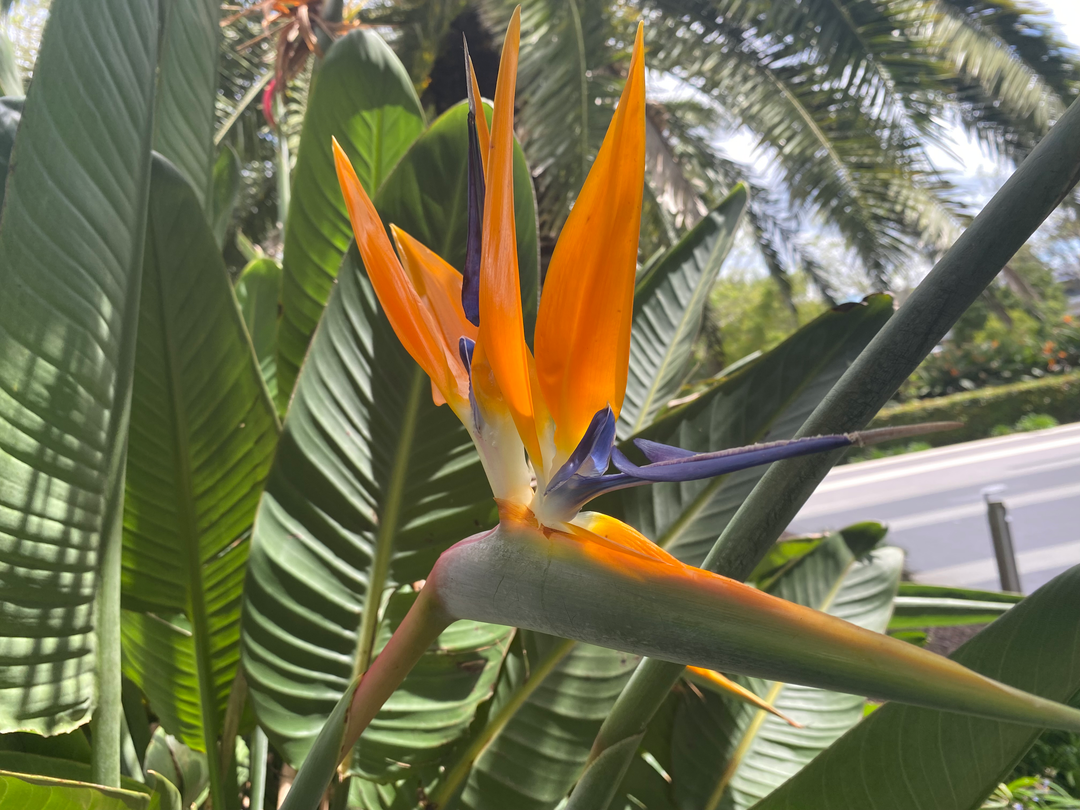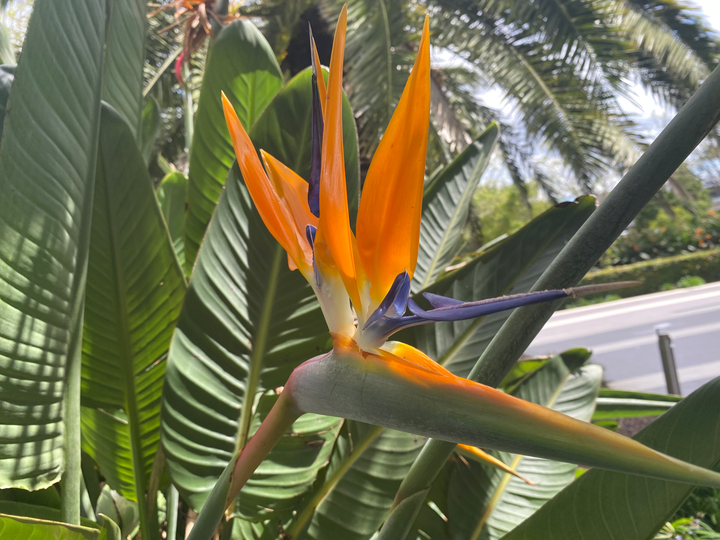Bird of paradise (Strelitzia reginae) is a stunning tropical plant that gets its name from its beautiful flowers, which resemble birds in flight. There are 5 varieties of Strelitzias with Strelitzia reginae being one of the most popular varieties. Strelitzia reginae is native to South Africa but thrives in many parts of Australia. Strelitzia reginae commonly called the bird of paradise or crane flower is a popular feature plant for landscaping in Australia because of its hardy nature and beautiful foliage and flowers. This striking plant is relatively easy to care for and planting the reginae in your garden will add a tropical look to your garden, so order yours today! Keep reading to learn everything you need to know about growing a bird of paradise in your garden or home!
Characteristics
The Bird of Paradise plant has large, thick leaves that can grow up to three or four feet long. The flowers emerge from thick, upright stalks and consist of three bright orange or white petals with three deep blue petals that create a pointed shape at the top of the flower. The plant blooms in winter and spring and can produce up to 36 flowers per year.
The Bird of Paradise plant is ideal for those who enjoy low-maintenance plants, as it is a hardy plant that can survive in a variety of conditions. However, it is important to provide it with adequate care to ensure that it thrives and produces beautiful flowers year-round.
Bird of paradise growth rate
The bird of paradise has an intermediate growth rate taking 4-5 years to mature and start blooming.
Bird of paradise growth rate size
It can reach up to 3m tall and 2.5m wide in its natural habitat, but more likely to reach a height of 1.5 – 2m and a width of 1-1.5m in cultivation.
Ultimate Care Guide for Your Bird of Paradise
If you're a fan of exotic plants, you've undoubtedly come across the stunning Bird of Paradise. Known for its striking orange and blue flowers resembling the head of a tropical bird, this plant is a popular choice for both indoor and outdoor gardens. But how do you ensure your Bird of Paradise thrives in its environment?
This care guide will cover everything you need to know about caring for your Bird of Paradise plant, including its ideal environment, potting and repotting, watering and humidity requirements, pruning and maintenance, fertilizing and nutrients, common pests and diseases, propagation methods, and troubleshooting common issues. By following these guidelines, you'll be able to enjoy the beauty of your Bird of Paradise for years to come.
Choosing the Right Environment
When it comes to growing a Bird of Paradise plant indoors, creating the perfect environment is crucial for its survival. These tropical beauties prefer bright, indirect light and consistent temperatures without frost.
If your home doesn't provide the ideal amount of natural light, you can supplement with artificial light sources. Placing your indoor Bird of Paradise near a south-facing window or under a grow light can help it thrive.
It's also important to maintain consistent humidity levels between 50-70% for optimal growth. In Sydney you do not need to supplement with humidity however in places with lower humidity, you can use a humidifier or place a tray of water nearby to add moisture to the air.
Make sure to avoid exposing your Bird of Paradise to drafts or sudden temperature changes, as this can cause stress and affect its overall health.
Potting and Repotting
Birds of Paradise thrive best in pots that are slightly larger than their root system. When selecting a pot for your plant, choose a container that is 5-10 cms wider in diameter than the current pot. The container should also have drainage holes to prevent water from accumulating at the bottom and causing root rot.
It is recommended to use a soil mix that includes ingredients such as peat moss, perlite, and vermiculite, which provide good drainage and aeration. This will help prevent soil compaction and allow the roots to access the nutrients they need.
When repotting, it is important to be gentle with the roots and not damage them. Carefully remove the plant from its current pot and loosen the roots before placing it in the new container. Fill the gaps around the root ball with fresh soil mix and ensure the plant is secure and stable in its new pot.
| Tip: | Repot your Bird of Paradise plant every 2-3 years to ensure it has enough space and nutrients to thrive. |
|---|
After repotting, water the plant thoroughly and allow any excess water to drain away. Avoid fertilizing the plant for a few weeks after repotting to allow it to acclimate to its new environment.
Watering and Humidity
Watering your Bird of Paradise plant appropriately is a crucial part of its care routine.
During the growing season, which is in the spring and summer, you should water your bird of paradise frequently. Ensure that the soil is moist but not waterlogged. Allow the top 5 cm of soil to dry out before watering again. In the winter, reduce watering to once every two weeks.
Your bird of paradise plant prefers high humidity. Mist the leaves regularly with room temperature water to increase humidity levels. Alternatively, you can place the plant on a tray of pebbles and water to help increase humidity. The pebbles prevent the plant from sitting in water, which can lead to root rot.
In addition to misting and using humidity trays, you can also invest in a humidifier to keep the air around your bird of paradise plant moist.
Pruning and Maintenance
Proper pruning is necessary for the healthy growth of your Bird of Paradise plant. The removal of dead or damaged leaves can improve the plant's appearance and overall health.
It is recommended to use clean, sharp pruning shears for the process to prevent damage to the plant. Always make sure to sterilize your pruning shears with rubbing alcohol or bleach before use to prevent the spread of diseases.
When to Prune
Pruning can be done throughout the year but it is best to do it during the growing season, which is in spring or summer. If you notice any dead, yellow or damaged leaves, remove them as soon as possible.
If you want to shape your plant, wait until it has fully grown before you start pruning. Once your plant has reached its desired height, you can start removing lower leaves to create a more tree-like appearance.
How to Prune
Start by identifying the leaves that need to be removed. Cut as close to the base of the leaf as possible without damaging any other leaves or stems.
For larger leaves, use a saw or sharp knife to cut them off. Be sure to create a clean cut and avoid damaging the stem.
It's best to avoid pruning too much foliage at once, as this can shock the plant and slow its growth. Instead, prune a few leaves at a time and wait for the plant to recover before pruning any more.
Other Maintenance Tips
Bird of Paradise plants require moderate to high levels of humidity. Mist the leaves regularly or place a tray of water near the plant to increase humidity.
Regularly wiping the leaves with a damp cloth can also help remove dust and debris, allowing the leaves to absorb more sunlight.
If your plant starts to get too large, you can divide it into smaller plants. Gently remove the plant from its pot and separate the roots. Replant each section in a pot with fresh soil.
Following these pruning and maintenance tips will ensure the healthy growth and longevity of your Bird of Paradise plant.
Fertilizing and Nutrients
Proper fertilization is key to keeping your Bird of Paradise plant healthy, and it is essential to provide it with the necessary nutrients to promote healthy growth. The best way to feed your plant is by using a slow-release fertilizer that provides a steady supply of nutrients over time.
It is important to note that too much fertilizer can harm your plant, so be sure to follow the recommended dosages on the fertilizer packaging. In general, fertilize your Bird of Paradise once every three to four months during the growing season, which is typically between spring and summer months.
Essential Nutrients
Bird of Paradise plants require several essential nutrients for healthy growth, with the most important being nitrogen (N), phosphorus (P), and potassium (K). Nitrogen is critical for leaf development, phosphorus is essential for root growth, and potassium contributes to overall plant health.
In addition to these primary macronutrients, your Bird of Paradise also needs secondary macronutrients such as calcium, magnesium, and sulfur, as well as micronutrients such as iron, manganese, and zinc. These nutrients can be found in most commercial fertilizers specifically formulated for indoor plants.
Fertilizing Tips
- Always read the instructions on your fertilizer package before application.
- Water your plant before fertilizing to prevent burning the roots.
- Apply the fertilizer evenly around the base of the plant, avoiding direct contact with the foliage.
- Use a diluted fertilizer solution for young or newly potted plants.
- Do not fertilize your Bird of Paradise during its dormant period, which occurs during fall and winter months.
Dealing with Common Pests and Diseases
Bird of Paradise plants are relatively hardy and can withstand some pests and diseases. However, it is important to monitor your plant regularly and take prompt action if you notice any signs of infestation or illness.
Common Pests
The most common pests that may affect Bird of Paradise plants include spider mites, scale insects, and mealybugs. These pests feed on the plant's sap, causing damage to the leaves and stems.
You can control spider mites by misting the leaves with water and wiping them down with a damp cloth. For scale insects and mealybugs, you can use a cotton swab dipped in alcohol to dab the affected areas. Alternatively, you can apply insecticidal soap or neem oil to combat these pests.
Another pest that may infest Bird of Paradise plants is the caterpillar of the Common Crow butterfly. This pest can be removed manually or with a natural insecticide.
Common Diseases
Bird of Paradise plants may be susceptible to fungal diseases such as leaf spot and root rot. These diseases can be caused by overwatering or poor drainage.
To prevent leaf spot, avoid getting the leaves wet when watering and ensure good air circulation. If root rot occurs, you may need to repot the plant in fresh, well-draining soil.
Prevention
To prevent pests and diseases, it is important to maintain good plant hygiene. This includes regularly dusting the leaves, removing any dead or yellowing leaves, and keeping the plant in a clean environment.
Additionally, make sure your Bird of Paradise plant is not overcrowded and has enough space to grow. Overcrowding can create a humid environment that is conducive to pest and disease infestations.
Propagation Methods
Bird of Paradise plants can be propagated through division or seed germination. Division is the most common method and is best done during spring or early summer when the plant is actively growing.
To propagate through division:
- Choose a healthy plant with multiple stems.
- Gently remove the plant from its pot and separate the stems, making sure each section has a healthy root system.
- Plant each stem in a new pot with fresh potting soil, making sure the soil is evenly moist.
- Place the newly potted plants in a warm, bright spot and keep the soil consistently moist until new growth appears.
Seed germination is a more time-consuming method but can produce new plants with unique characteristics.
To propagate through seed germination:
- Collect seeds from the ripe, orange fruit that appears after the plant has flowered.
- Clean the seeds by soaking them in water for a day, then rubbing off the fleshy coating.
- Plant the seeds in a well-draining potting mix, covering them with a thin layer of soil.
- Keep the soil consistently moist and place the pot in a warm, bright spot. Germination can take several weeks to a few months.
Propagation can be a rewarding way to expand your collection of Bird of Paradise plants. With patience and care, you can successfully propagate new plants and enjoy the unique beauty of the Strelitzia for years to come.
Troubleshooting Common Issues
Despite your best efforts, your Bird of Paradise plant may encounter some issues along the way. Here are some common problems you may encounter and how to resolve them:
|
Pale or Yellowing Leaves |
If the leaves of your Bird of Paradise plant are turning pale or yellow, it may be a sign of overwatering. Check the soil moisture level and let it dry out before watering again. Ensure that the plant is not placed in direct sunlight as this may also cause yellowing of leaves. |
| Brown Leaf Tips | Brown leaf tips can indicate a lack of humidity. Place a humidifier nearby or mist the leaves with water daily. Ensure that the plant is also not located near any air conditioning or heating vents that may cause dry air. |
| No Flowers | If your Bird of Paradise plant is not producing any flowers, it may be due to insufficient light. Ensure that the plant is receiving adequate bright, indirect light to encourage flower growth. Alternatively, the plant may not be mature enough to produce flowers, as it can take up to five years for some varieties to bloom. |
| Wilting or Drooping Leaves |
Wilting or drooping leaves can indicate underwatering. Check the soil moisture level and water the plant thoroughly, ensuring that the excess water drains out of the pot. Alternatively, the plant may be rootbound and in need of repotting. |
|
Yellow or Spotted Foliage |
Yellow or spotted foliage may indicate a pest problem. Check the plant for any signs of pests, such as spider mites or mealybugs, and treat them accordingly with a natural insecticide or neem oil. |
With proper care and attention, your Bird of Paradise plant should thrive and become a gorgeous addition to your indoor garden. By addressing any issues promptly and following the care guide, you can help your plant overcome any challenges and flourish.
Frequently Asked Questions (FAQs)
Here are some common questions about Bird of Paradise care:
-
Can Bird of Paradise plants grow indoors?
Yes, Bird of Paradise plants can thrive indoors as long as they receive adequate light (at least 1 hour direct sunlight and bright indirect light for the remainder of the day) and the environment meets their requirements.
-
How often should I water my Bird of Paradise plant?
It is best to let the top 5 cm of soil dry out before watering your Bird of Paradise plant. Aim to keep the soil evenly moist, but avoid overwatering, which can cause root rot.
-
Do Bird of Paradise plants need fertilizer?
Yes, Bird of Paradise plants benefit from regular fertilization during the growing season (spring and summer). Use a balanced fertilizer every 2-3 weeks at half the recommended strength.
-
What pests and diseases should I watch out for?
Spider mites and scale insects can be problematic for Bird of Paradise plants. They can also be susceptible to fungal diseases such as root rot and leaf spot.
-
Can I propagate my Bird of Paradise plant?
Yes, Bird of Paradise plants can be propagated through division or by seed germination.
Conclusion
In summary, caring for your Bird of Paradise plant requires attention to its unique needs, from lighting and humidity to proper potting and fertilization. By following the guidelines outlined in this care guide, you can ensure that your Bird of Paradise remains healthy and vibrant, adding a touch of tropical beauty to your indoor space.
We hope that this guide has provided you with the information you need to successfully care for your Bird of Paradise plant. Remember, the key to a thriving plant is consistent care and attention. By providing your Bird of Paradise with the right environment, proper nutrients, and vigilant maintenance, you can enjoy its beauty for years to come.
Light requirement: Full Sun, Part sun/part shade, and Bright indirect sunlight
Water requirement: Low
Watering frequency:
Soil:
Skill level: Beginner
Growth rate: Intermediate
Suitable for containers: Yes
More info:
External links to more info:
Drought tolerance: Medium
Frost tolerance: Medium
Wind tolerance: High
Disease and pest susceptibility:
Mature height:
Mature width:
Suitable for shaping:
Colour: Green
Variegation: No
Size: Large
Seasonality: Evergreen
Flowering: Yes; profuse/bright display
Flower colour: Bright orange and blue
Flower fragrant:
Flowering season:
Fruit:
Let customers speak for us
























